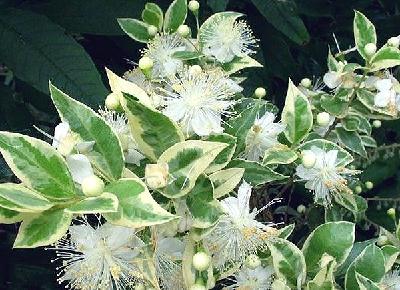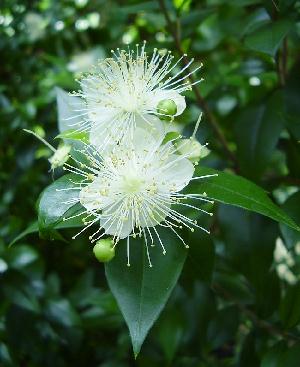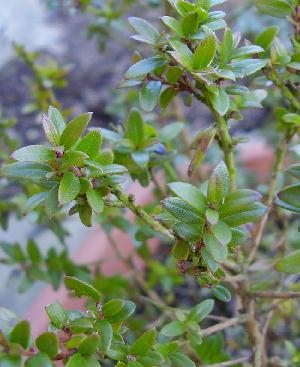Myrtle

Myrtus Communis 'Variegata'
It's very cold this month in Derby and my herb garden still has very little in the way of fresh leafy growth, to draw on for inspiration. Plus my herbs are currently sleeping under a light blanket of snow, dreaming of the warm summer to come and all the growth that they're going to make, I hope!
Whilst I wait for the herbs to emerge and for the weather to warm up, so I can begin work pruning, planting and planning this year's changes and additions, I've been passing the time by looking at the herb photographs I took last summer. A batch I took of some myrtle plants caught my eye. Looking at them I can bring to mind the sweet, orangey, warm spicy scent I experienced and my mind is taken back to warm fragrant summer days. The photographs were enough to take off the chill of the cold snowy March weather, so I decided that myrtle would be worth writing about this month. If it brought some sunshine to me, it may bring some sunshine to others?
History
Myrtle (Myrtus) belongs to the Myrtaceae family of plants that also includes clove, allspice, eucalyptus and bog myrtle amongst its species.
Native to southern Europe and north Africa, myrtle has been cultivated for many years and these days it is mainly grown for its essential oil.
Folklore

Myrtus communis
Sacred to the Goddess Astarte also known as Aphrodite, myrtle has long been associated with love and romance. In Victorian times it was a favourite item in bridal wreaths and in tussie mussies. In the language of flowers myrtle represented love and marriage and love in absence. However a chaplet of myrtle was also worn by brides at their wedding ceremonies to help them avoid being 'with child' too quickly.
In herbal folklore myrtle is imbued with the mystical powers of love, fertility, peace, money and youth. It is said that if myrtle is grown either side of the front door then peace will always be within the home. Grown in window boxes, especially if planted by women, myrtle is said to bring luck and money to the household.
Description
True Myrtle (Myrtus Communis) is a tender evergreen shrub with dense dark green leaves, which are about 5cm (2") in length and lance shaped. The leaves have a sweet, spicy and aromatic fragrance when crushed or bruised. In late spring and summer the shrub is covered in wonderfully scented flowers that are creamy white, and look very exotic. The flowers are followed by blue-purple berries. Other species of myrtle include myrtle communis ssp. tarentina, with smaller leaves than true myrtle, and myrtle communis 'variegata', the variegated myrtle seen above.
Growing
Myrtle prefers to be grown in well drained fertile soil in full sunlight. If you have mild winters then you can plant your myrtle in the ground, but preferably plant it against a south facing wall. If you don't have a south facing position available, then plant your myrtle in a tub that can be moved indoors or taken into a green house to protect your myrtle from frost and harsh weather. Cover with protective fleece or a bubble wrap jacket and keep protected until all signs of frost have passed.
Myrtle responds well to a light pruning in the spring to help it regain its shape after the previous year's growth. Left to its own devices myrtle can turn into a woody shrubby tree with bare branches at its base.
Feed lightly with a liquid fertiliser during the flowering season only. Be careful not to over water your myrtle because they tend to suffer from root rot if over watered.
General Use

Myrtle communis ssp. tarentina
The wood is used for making walking sticks and for turning various wooden items including drinking cups and bowls. Because of the wonderful grain it is also used to make items of furniture and musical instruments.
Myrtle's twiggy growth makes excellent kindling for fires and adds a nice smokey flavour to food when sprinkled on barbecues.
The leaves make a useful addition to homemade pot pourri, although long term storage of myrtle leaves can see their deep green colour fade to a pale greeny yellow if not stored out of direct sunlight.
Its roots and bark are also used in the tanning of leather.
Medicinal Use
Myrtle's astringent, tonic and antiseptic properties are used to heal wounds. It is also a tonic and has calmative properties and is considered to be a good remedy for disorders of the digestive and urinary systems. Its anti-catarrhal and expectorant properties make it useful for treating chest complaints.
Myrtle essential oil is used in aromatherapy to help the circulation and for massages to help treat varicose veins when diluted in a suitable carrier oil such as sweet almond oil. Myrtle oil is milder than eucalyptus oil making it more suitable for use to treat children's ailments.
Culinary Use
Myrtle berries are used to season pork and gamey dishes much like juniper berries and black peppercorns. The leaves are used in savoury dishes such as stuffing's. In Sardian, Italy, the locals make a liqueur called mirto by infusing myrtle berries in a mixture of water, sugar and alcohol. It has digestive and stomatic properties.
My apologies but there is no recipe this month. I have yet to try cooking with myrtle, so had no experience to draw on and didn't like to pinch someone else's recipe. So if anybody has any recipes using myrtle, please share them on the Forum. I'd love to try cooking with this wonderful herb this summer.
